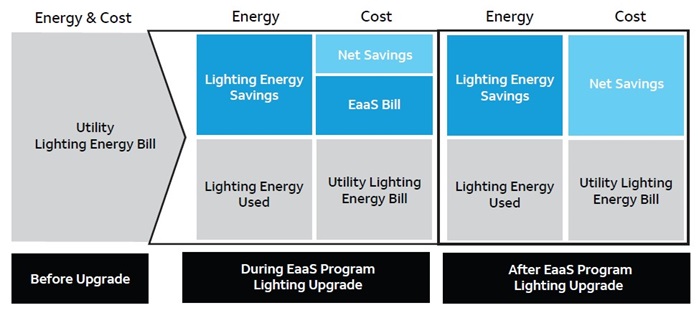- Energy as a Service
- IoT
- Commercial and Industrial
- Telecoms
AT&T Deploys Efficiency as a Service Solutions Enhanced by IoT

Many corporate commercial and industrial (C&I) energy and sustainability managers struggle to secure capital for non-core operations, like energy management, and look to financing options to meet their operational efficiency and sustainability goals. Across the Guidehouse Insights Energy as a Service solutions framework, efficiency as a service financing models for lighting upgrades offer an attractive option for companies looking to scale their efforts. These models create immediate electricity and cost savings without upfront capital investment.
A lighting efficiency as a service agreement is analogous to a solar PV power purchase agreement in the sense that sources of private capital are used within a project finance instrument. However, in a lighting efficiency as a service agreement, service payments by the C&I energy user are based on actual avoided kilowatt-hours of electricity from lighting upgrades. A recent lighting efficiency as a service program by AT&T highlights the benefits of this solutions model.
Lighting Efficiency as a Service Overview

(Source: AT&T)
AT&T's Partnership with Redaptive
AT&T partnered with Redaptive to deploy lighting efficiency as a service solutions that used AT&T Internet of Things connectivity technology across Redaptive’s platform to measure and monitor energy savings. The lighting efficiency as a service solutions were installed at a variety of AT&T facilities, including administrative buildings, data centers, retail stores, work centers, and telecom equipment buildings in the US. Since 2017, the program has enabled AT&T to reduce electricity consumption in 647 facilities that produced almost $20 million of annual avoided electricity utility payments, reducing electricity usage by 183 million kWh.
New: Energy as a Service Research Segment
Efficiency as a service solutions, like AT&T’s lighting solutions, help avoid capital outlays and allow for the transfer of project execution risk to a third-party vendor across a large portfolio of sites. Guidehouse Insights will be keeping a close eye on further portfolio-wide deployments like this within its new Energy as a Service research coverage.